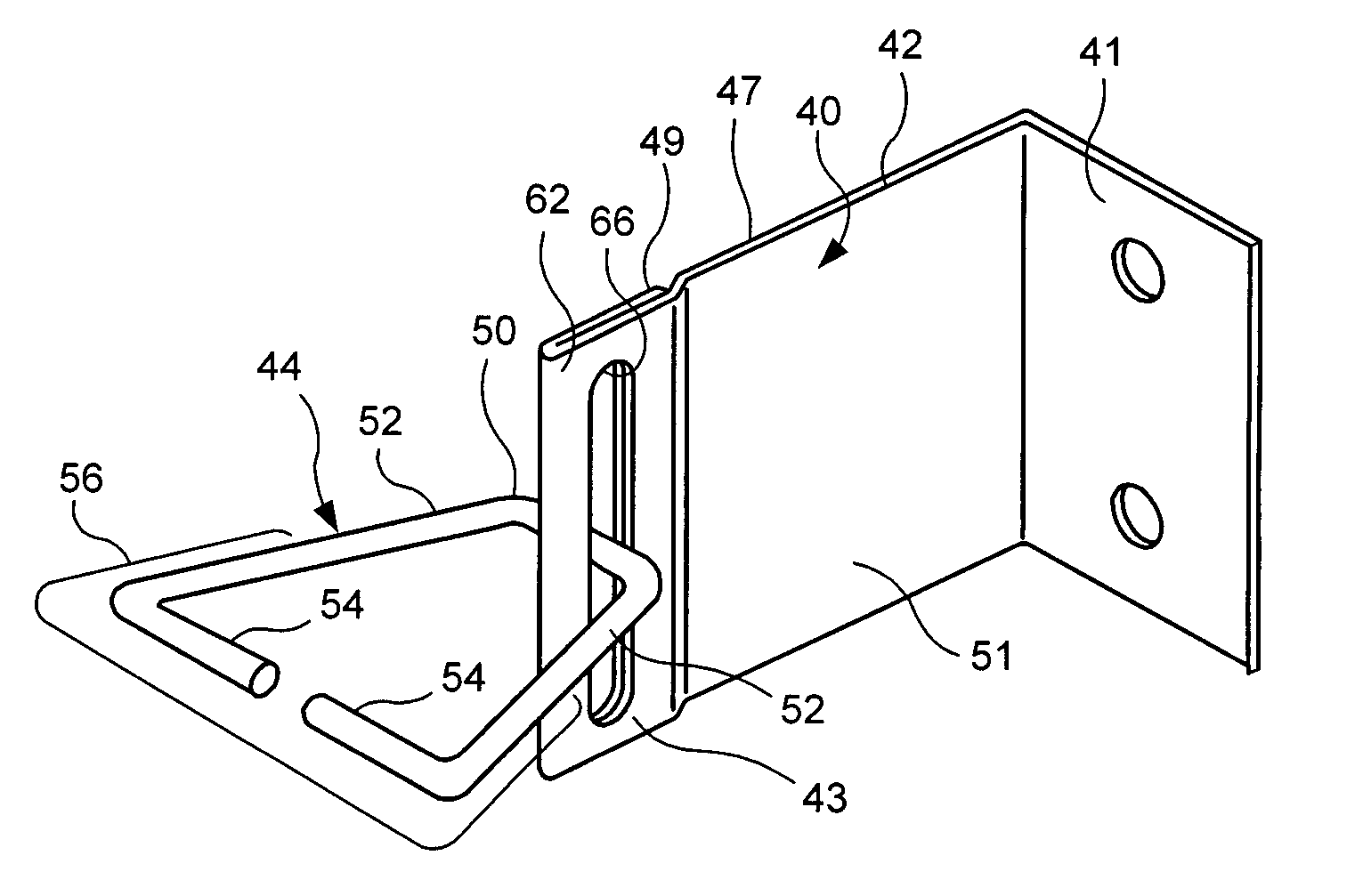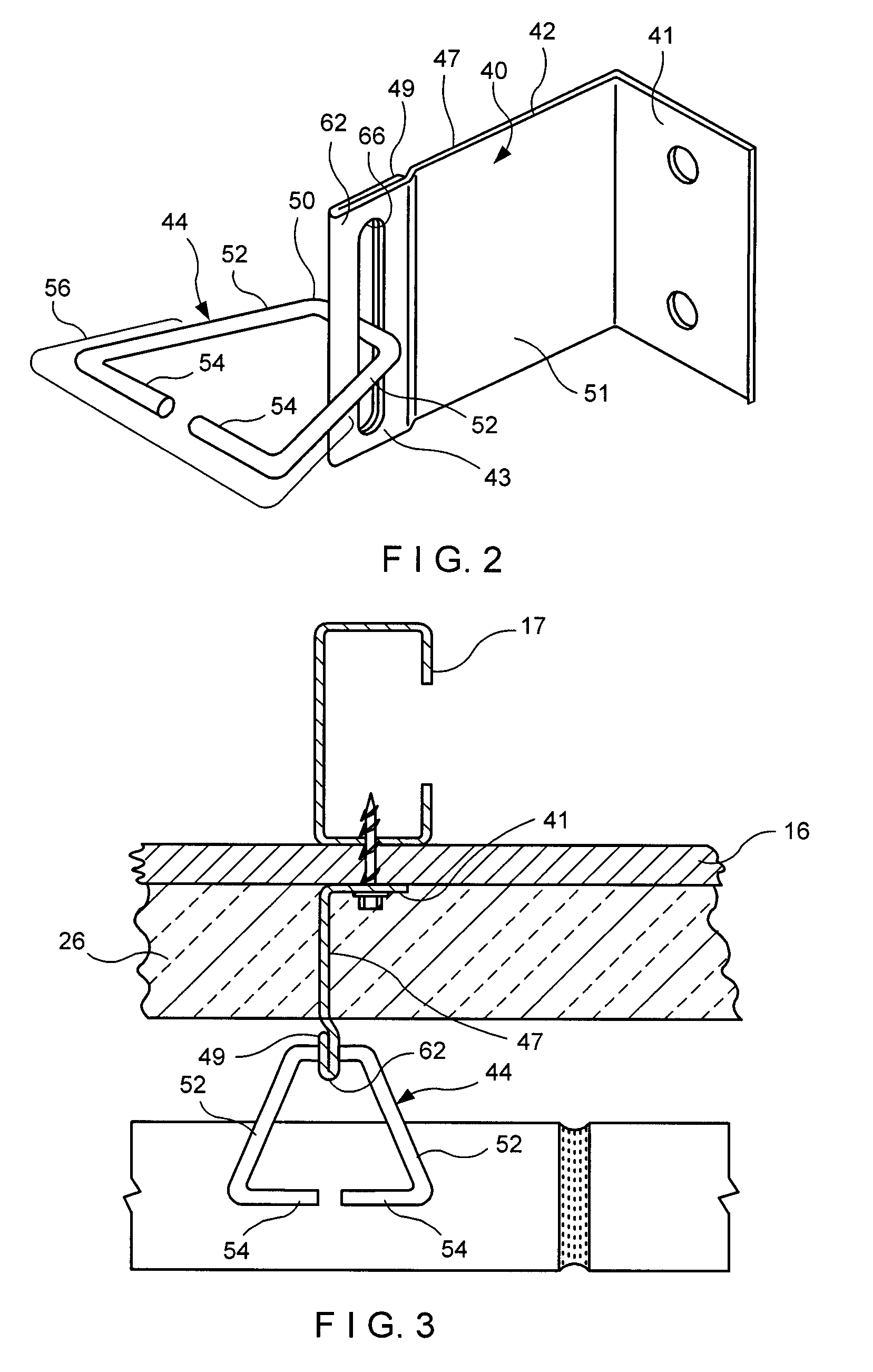Wind load anchors and high-wind anchoring systems for cavity walls
a technology of wind load anchoring and cavity walls, which is applied in the direction of walls, ceilings, building components, etc., can solve the problems of brick veneer anchoring to a variety of backup walls facing a lack of standards, mortars of poor quality, and change, so as to achieve maximum pull resistance, prevent disengagement, and high strength
- Summary
- Abstract
- Description
- Claims
- Application Information
AI Technical Summary
Benefits of technology
Problems solved by technology
Method used
Image
Examples
first embodiment
[0064]This anchoring system, discussed in detail hereinbelow, has a high-strength wall anchor with a doubled-walled wing and a veneer tie. The base of the wall anchor is surface mounted on an insulated dry wall structure. In the first embodiment, the inner wythe of the cavity wall has an exterior panel-type insulation vertically disposed thereon. As the veneer being anchored is a brick veneer, the anchoring system includes sufficient vertical adjustment so as to avoid any misalignment.
[0065]Referring now to FIGS. 1 through 4, the first embodiment shows a surface-mounted anchoring system suitable for cavity wall constructs under high-wind load conditions. The high-wind load anchoring system for cavity walls is referred to generally by the numeral 10. A cavity wall structure 12 is shown having an inner wythe or dry wall backup 14 formed from sheetrock or wallboard 16 mounted on metal studs or columns 17. The cavity wall 12 also includes an outer wythe or facing 18 of brick 20 construc...
second embodiment
[0080]The wall anchor construct of the second embodiment is seen in more detail in FIGS. 6 and 7. Two double-walled wings 143, vertically disposed, extend horizontally from and coextensively with the base 141 of the wall anchor 140. Each double-walled wing 143 is contoured with a vertically elongated aperture 166 which interengages with the rear leg 150 of the veneer tie 144 that is threaded therethrough. The aperture 166 is constructed to be within predetermined dimensions to restrict movement along the z-axis. The dimensional relationship between the aperture 166 and the veneer tie 144 permits range of movement of the veneer tie 144 along the y-axis 136 while limiting z-axis 138 movement. As a result of this structural arrangement, the veneer tie 144 remains horizontally disposed within the x-z plane of bed joint 130 so that external compressive forces bearing against the face of the outer wythe 118 are transmitted along the veneer tie body 144 and not broken into components.
[0081...
third embodiment
[0088]In the third embodiment, the improvement is the enhanced strength and performance of the double-walled wing structure 243 which absorbs the burden of high-wind forces to resist deformation of the wall anchor 240 coupled with the snap-in wire 265 structure which provides reinforcement against seismic forces, thereby providing improved connection security and motion stability to the high-wind load anchoring system 210 of this invention. Maximum pull resistance is achieved when the juncture of the double wall 249 is formed to align with the central plane 247 of the single planar wall 251.
PUM
 Login to View More
Login to View More Abstract
Description
Claims
Application Information
 Login to View More
Login to View More - R&D
- Intellectual Property
- Life Sciences
- Materials
- Tech Scout
- Unparalleled Data Quality
- Higher Quality Content
- 60% Fewer Hallucinations
Browse by: Latest US Patents, China's latest patents, Technical Efficacy Thesaurus, Application Domain, Technology Topic, Popular Technical Reports.
© 2025 PatSnap. All rights reserved.Legal|Privacy policy|Modern Slavery Act Transparency Statement|Sitemap|About US| Contact US: help@patsnap.com



